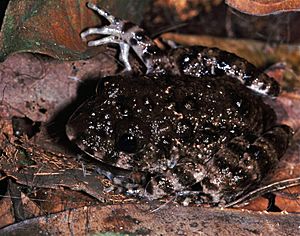Scotobleps facts for kids
The Gaboon forest frog (scientific name: Scotobleps gabonicus) is a special type of frog. It is the only species in its group, called Scotobleps. This frog belongs to the Arthroleptidae family. You can find these frogs in parts of Africa. They live in eastern Nigeria, Cameroon, Equatorial Guinea, Gabon, and the Republic of the Congo. They also live in the Democratic Republic of the Congo. They might even be found in a small area of Angola called the Cabinda Enclave.
Quick facts for kids Scotobleps |
|
|---|---|
 |
|
| Conservation status | |
| Scientific classification | |
| Synonyms | |
|
Astylosternus gabonicus (Boulenger, 1900) |
Contents
What Does the Gaboon Forest Frog Look Like?
Male Gaboon forest frogs can grow up to about 52 millimeters (2 inches) long. Female frogs are a bit bigger, reaching about 70 millimeters (2.8 inches) in length. Their head is quite large, being as long as it is wide.
Body Features
The frog's snout is somewhat pointed. It has large eyes. Its fingers and toes are long and have slightly puffy tips. The tips also have strong bumps underneath them. The toes are half-webbed, which helps them move in water.
Skin and Color
The skin of the Gaboon forest frog is usually smooth. Sometimes, it has small, flat bumps on its back. The back of the frog is olive-brown with small, dark spots. It has a dark stripe between its eyes. The upper lip has dark vertical lines. One of these lines goes down onto the lower lip, right below the front part of the eye. Its legs have dark stripes across them. The belly of the frog is white.
Where Do Gaboon Forest Frogs Live?
The Gaboon forest frog is a common animal in areas that are not very high above sea level. It lives in lowland rainforests. This includes forests that have grown back after being cut down.
Habitat and Breeding
These frogs like to breed in moving water. They prefer wide, shallow streams that have sandy banks. However, they can also breed in faster-moving streams called torrents.
Protecting Their Home
Sadly, the number of Gaboon forest frogs is going down. This is because their forest homes are being lost. Protecting these rainforests is important to help these frogs survive.
See also
 In Spanish: Scotobleps gabonicus para niños
In Spanish: Scotobleps gabonicus para niños


